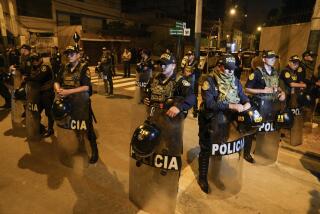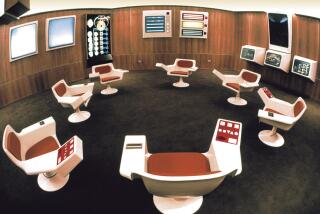Chilean Spy Center Becomes Home of ‘Allende’s Revenge’
- Share via
SANTIAGO, Chile — The mansion was used as a domestic spying center by the feared secret police of Gen. Augusto Pinochet. Now it will house works of art and be dedicated to the socialist overthrown by the general’s bloody 1973 coup.
The Salvador Allende Solidarity Museum, due to open in April, will exhibit work by the likes of Pablo Picasso, Roberto Matta and Joan Miro.
“This is Salvador Allende’s revenge,” said Jose Balmes, the Spanish-born director of the museum.
The remodeling of the mansion was a journey through the inner workings of the shadowy agency responsible for many of the dictatorship’s worst abuses. Workers found passports, papers with instructions to agents and diagrams of places under surveillance or targeted for operations.
“In the basement, we found a communications center used to tap telephones around the country,” Balmes said. “There was evidence many phones were tapped.”
Some of the rooms in the big two-story house in a middle-class neighborhood near downtown Santiago were used for interrogating detainees, although the place was not a jail, Balmes said.
The mansion served as the Spanish Embassy in the 1950s but then stood empty until the secret police took it over in 1973.
Another large house, Villa Grimaldi, served as a detention and torture center. That site, in a southern suburb of the capital, has been turned into a memorial to victims. Among those held there were Chile’s incoming president, Michelle Bachelet, and her mother, Angela Jeria.
The mansion converted into the Allende museum was purchased and remodeled with financial support from the Chilean government and several European countries.
Spy equipment found there is being left untouched, as a reminder of what the house was before, said Balmes, 79, who came to Chile in 1939 to get away from Gen. Francisco Franco’s dictatorship in Spain.
“The place is a memorial,” he said.
Documents found by the workers were turned over to Hugo Dolmetsch, one of several judges investigating human rights abuses under Pinochet.
Many of the artworks to be exhibited come from a museum established by Allende in 1972.
Allende, a socialist who was democratically elected in 1970, died, reportedly by suicide, as the presidential palace was under bombardment during Pinochet’s coup.
“There’s no other museum in the world like this -- all the works being exhibited were donated as a tribute to Allende and his government,” Balmes said.
The secret police, known as DINA in Spanish, tortured, kidnapped and killed dissidents under Pinochet’s regime. Its top commanders, including at least six retired generals, have been tried and jailed.
Pinochet, 90, is facing charges in a number of human rights cases, but previous attempts to prosecute him have been halted because of his poor health.
According to a report by an independent commission appointed by the civilian government that succeeded Pinochet, 3,190 people were killed for political reasons during his rule.
More to Read
Sign up for Essential California
The most important California stories and recommendations in your inbox every morning.
You may occasionally receive promotional content from the Los Angeles Times.













